Newsletter

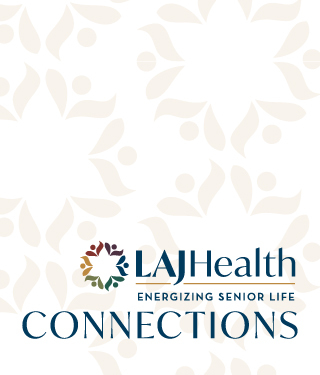
Our Newsletter
Connections
Jun
5
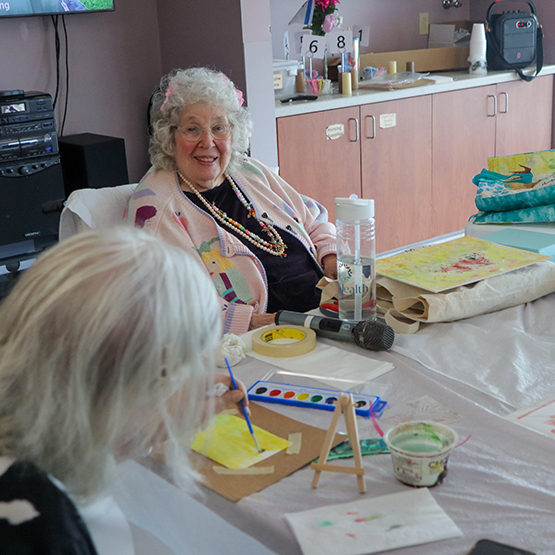
New Activity Group Leaves Residents Feeling Positively Great
For Los Angeles Jewish Health resident Arlene Bercu, life is about making the most of every moment. The 90-year-old Winnipeg transplant has always greeted each day with enthusiasm, but her embrace of glass-half-full optimism has recently taken on new meaning—and, as she tells it, today her glass overflows with thankfulness and fulfillment.
“Last year, I got COVID and also took a fall at the same time and ended up being hospitalized for five days. When I came back to Los Angeles Jewish Health, I went into rehab, and the kindness, care, and love of the staff was amazing,” she enthuses. “I know God took me on a spiritual odyssey and put those people on my path, and it made me so grateful.”
Channeling that gratitude into action, at the suggestion of several Los Angeles Jewish Health staffers, Arlene decided to launch the Positivity Group, a monthly meeting of residents living on the Grancell Village campus, in its Joyce Eisenberg-Keefer Medical Center building. The idea, she says, is to help her fellow residents experience the kind of pure happiness they had when they were little children.
“We choose a theme for the meetings, and we welcome whoever wants to come,” Arlene says. “In April, which was our first gathering, the focus was music: We had residents singing and playing tambourines, castanets, and drums. People were smiling ear-to-ear, and seeing their faces light up made my soul soar.”
During the May meeting, Arlene—a talented artist who was selling her work on the Venice Beach Boardwalk into her 80s—led group participants in making bookmarks and postcards and painting on giant easels. “We even had Q-Tips for people who couldn’t hold brushes; you can paint with any manner of things!” she notes.
As Arlene sees it, the magic of the Positivity Group is its ability to connect residents with the sense of wonder and amazement they may not have felt since their earliest years.
“Adults are such perfectionists, and we can be so hard on ourselves. But, as kids, we’re more open and receptive to the idea that each of us is original, one-of-a-kind, a masterpiece,” she says. “That’s what I want our participants to understand: They can contribute in their own unique ways, whether it’s singing a song or painting a canvas, and their contributions are valued—and they are loved.”
At future meetings, Arlene hopes to lead the group in assembling gift baskets to be distributed to other residents. “We’ll have all sorts of treasures that will allow seniors to unlock their inner child, from checkers sets and dolls to Lincoln Logs and Play Doh,” she says. “Then we’ll tie the baskets up with beautiful raffia ribbon. It will be so wonderful!”
Arlene says helping residents harken back to their youth helps spark creativity and joy while also providing new opportunities for intellectual and spiritual growth.
“Just because we’re older doesn’t mean we have to stop learning,” she points out. “I believe God makes all things possible no matter our ages and that, if we just have faith, we’ll find we can accomplish so much. Fear is the only thing holding us back, and I hope that after coming to the Positivity Group, people will feel upbeat and excited about doing new things. I know I do: Every day is a gift, and I’m not afraid to try anything anymore.”
Arlene sold her work on the Venice Beach Boardwalk well into her 80s
Apr
30
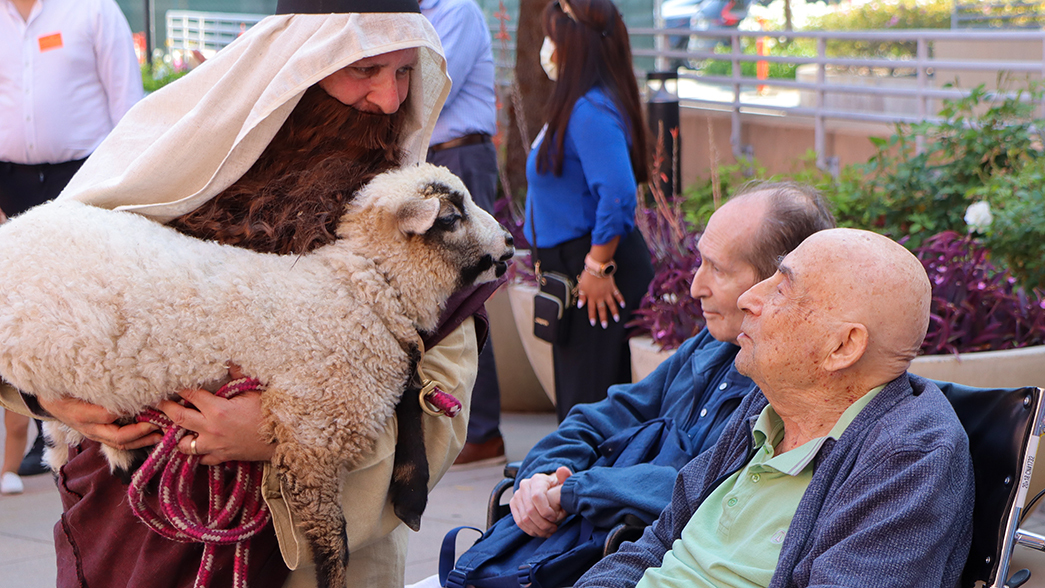
Passover 2024 a Time of Thoughtful Celebration at Los Angeles Jewish Health
During Passover this year, we were mindful of the instability around the world, vulnerability in Israel and unrest across our nation’s university campuses. Perhaps pulling at us the most is the status of hostages taken so many months ago.
It could have been tempting to alter Passover Seder plans this year. Instead, as the Jewish People have done for millennia, including those who call Los Angeles Jewish Health home, we recognized that the best way to honor the hostages and everyone suffering for their beliefs, was to conduct Seder in part as a tribute to those who continue to strive for freedom from oppression.
As we started Seder remembering our brothers and sisters in Israel, this was another opportunity to actively demonstrate our beliefs. These sacred traditions provide us with an anchor to hold onto and give us stability during these tumultuous times.
As we share just some of the many images of Passover at LAJH this year, imagine the warm and wonderful music and prayer that wrapped the seniors like a blanket of safety, stability and joy thanks to our wonderful rabbinical leaders, Chief Mission Officer, Rabbi Karen Bender and Rabbi Ronald Goldberg.
CLICK HERE FOR PASSOVER PHOTOS
Apr
30
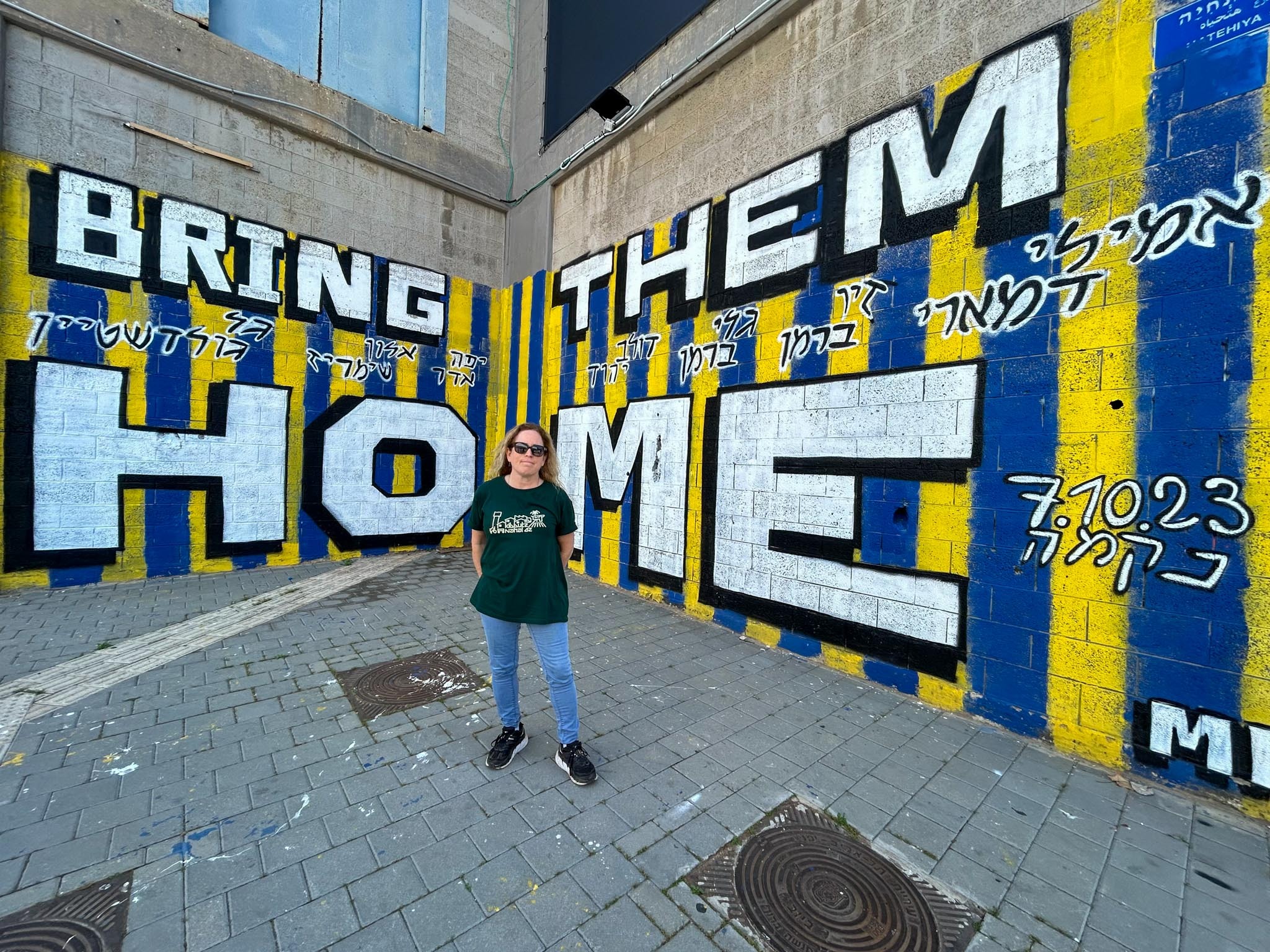
Rabbi Karen Bender Reflects on Mission to Israel
Rabbi Karen Bender, Chief Mission Officer of Los Angeles Jewish Health, recently returned from a mission to Israel. She was there to express solidarity with our Israeli brothers and sisters, demonstrate to them that they are not alone but rather that our hearts beat as one, bear witness to the massacres, lift up soldiers and family members of hostages, and volunteer by way of farming. Rabbi Bender describes that being there was in some ways like a shiva visit and in other ways like bikkur cholim, visiting the sick. In the Talmud the rabbis state that when you visit someone who is ill, you remove 1/60 of their suffering. Rabbi Bender hopes and prays she took away some of the Israelis' suffering by piercing their feelings of isolation, despair and grief.
On the flight home she wrote the following poem. Her reference to the strand of turquoise alludes to an ancient Jewish practice of adding a blueish strand to the tzitzit fringes of the prayer shawl. In those days, one would know that the sun had risen enough to say the morning Shma prayer if there was enough natural light to see the difference between the blue and white strand and the blue and white in the sky.
The Diameter of the Massacres*by Karen Bender - April 2024
The diameter of the massacreswas the length of Israeland the depth of the universe.It stretched to every continent,college campuses and social mediaIt spread information and disinformationTwisting and distorting moralityAnd redefining madnessIt wreaked havoc and wrecked livesIn Israel and GazaIn kitchens and living roomsIn bedrooms and porchesIn souls and hearts.
The diameter of the visitwas the length of Israelthe distance to Californiaand everyone and everywherewe will speak of it.The mission stretchedour compassion and mindsand challenged our faithin human nature.It struck us with awein every cell of our beingas we saw the resiliency of our peopleand as we strove together to answerthe unspoken question:Where shall we place all the pain?We were messengers and witnesses,representatives with wishes to helpand we did and we will.
The diameter of the hugsis the length of an Israeli flagand the width of a tallit large enoughto enwrap every Israeli who hurts right nowand therefore every Israeliwith the comfort of our loveand with a strand of techelet turquoisein the tzitzit to remind us all thatthe morning will come andwe will say the Shma someday with one voice.
*A reprise of Yehudah Amichai’s poem, “The Diameter of the Bomb”
Rabbi Karen Bender placing letters from residents in the Western Wall
Letters from residents put in the Western Wall
Sample letter given to Israeli soldiers
Apr
2
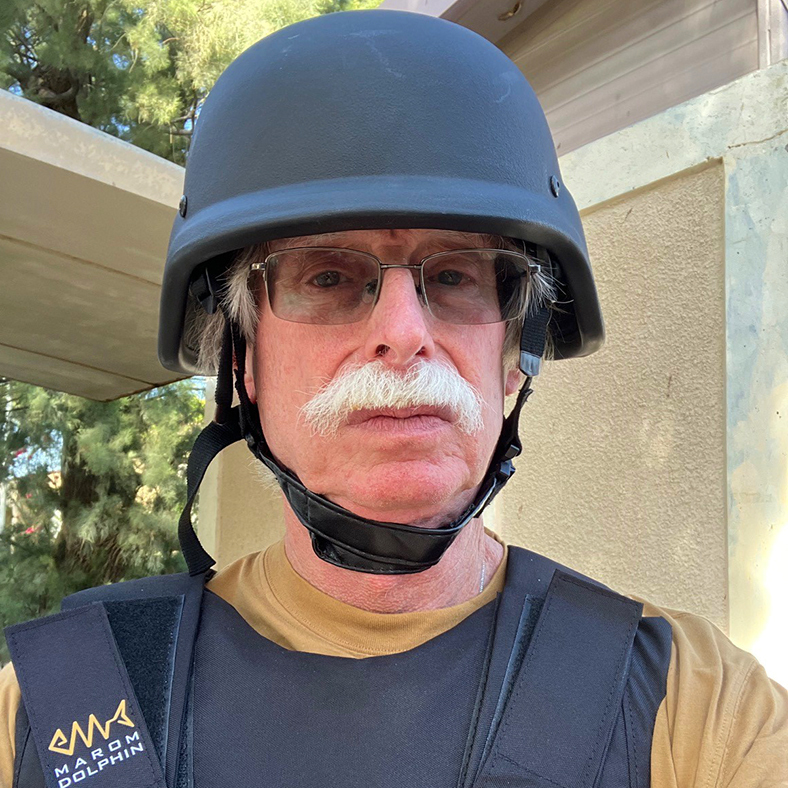
My Mission to Israel
by Rabbi Ronald Goldberg
This story is a first-person account by Rabbi Ronald Goldberg, of our Eisenberg Village Campus of Los Angeles Jewish Health, regarding his recent trip to Israel.
As has been the case for all of us, the devastating October 7th attack by Hamas on Israel, and the suffering and struggles of our brethren there, are heavy on my heart. From being a non-citizen volunteer in the Israel Defense Forces (צה”ל-TZHAL-IDF), to marrying a wonderful Israeli woman, to my year of rabbinic studies in Jerusalem, Israel has always been in my heart and thoughts and prayers.
When the opportunity arose in early December 2023 to take part in a volunteer mission to Israel, I didn’t walk – I ran to sign up, with my wife’s blessing. We both knew the work would be hard and emotional. Going into the program, the IDF required a signed waiver stating that I knew I was entering a closed military zone with active conflict and that the army could not be responsible for my safety. Without hesitation, I signed on the dotted line.
The mission took me to the region of Israel known as the Gaza Envelope, so called because it was in range of attack from Gaza. There I was blessed to do a variety of tasks. Some were mundane, like harvesting oranges on a kibbutz ravaged by the October 7th attack. Others were more emotional, such as working in an army rest camp just outside of Gaza and interacting as rabbi with soldiers fresh out of the territory. I gave them space to share their fears and hopes, I served them sandwiches and beverages, and I blessed them. At Sheba Hospital-Tel HaShomer, I did rotations with grievously wounded soldiers, hearing their stories, helping them face their fears, and blessing them and their loved ones.
In programs at Fountainview, I’ve described all these things in detail. I’m also always happy to discuss them again in person. But a message I want to share today here is about a slogan you see all over Israel – on bus benches, on the sides of buildings, and on the lower corner of TV screens during broadcasts. The message is ביחד ננצח : Together we will triumph.
This is the overwhelming feeling you get all over Israel. Not despair or defeat, but a sense of everyone being all together – a sense that, as one, the nation will succeed in its endeavor to keep its citizens safe. That, despite the efforts of those who murder young people at a music festival, Israel will live, Israel will prosper, and yes, Israel will dance and sing again. It’s not about triumph in battle, it’s about showing that evil will never drown out joy, never drown out love and caring, and that, just as we danced and sang on October 6th, so, too, we will dance and sing again today, tomorrow, and indeed עד עולם –forever. This was my takeaway from the trip: We should never ever forget that עם ישראל חי – the People Israel yet live.
Rabbi Ronald Goldberg Volunteer Mission to Israel
Apr
2
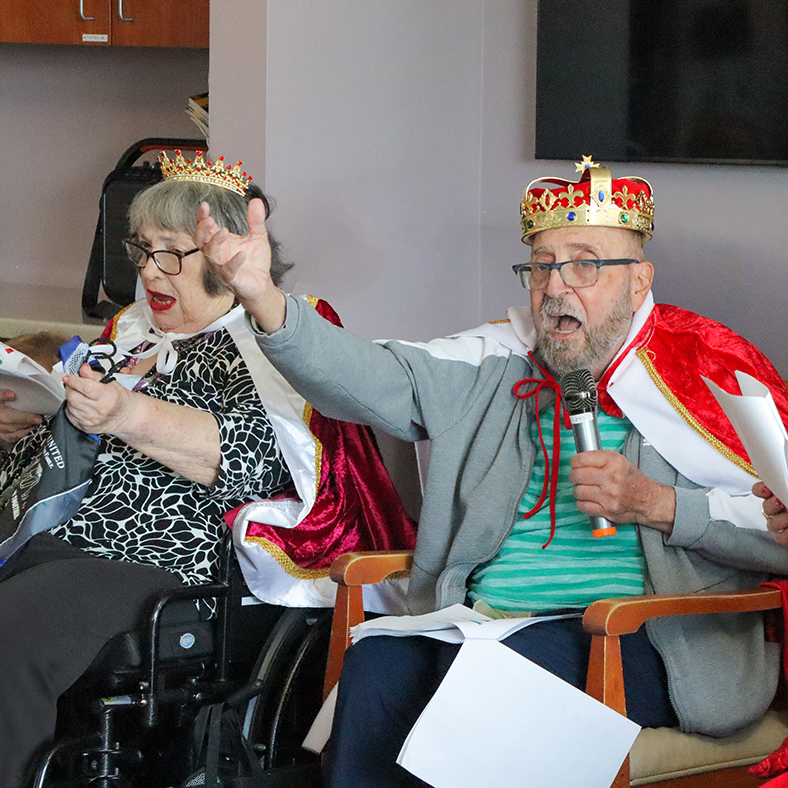
Purim is Celebrated at Los Angeles Jewish Health
Since the time of Purim last year, many disturbing worldwide events have occurred causing pain, anguish and heartache. We began the year in disbelief that a war continued to rage across Ukraine. While we prayed for a peaceful resolution, the unimaginable occurred as the entire world witnessed an innocent music festival in Israel turned into the site of a deadly and evil atrocity. During the following days, through the media we saw men, women and children ripped from the safety of their homes and thrust into a darkness that continues with no certain end ahead.
During times that feel so dire, why do we insist on carrying on with a lighthearted festival where people dress up in silly costumes, sing funny songs, and act out the reading of the Megillah, often adapting it to the tune of more contemporary music?
The answer is because it is more important than ever to carry out these customs, indeed to celebrate them!
We must first understand that the meaning of Purim is to celebrate the fact that Jews overcame the possibility of being destroyed at the hands of an evil entity. That by being strong and resolute no matter what, by standing up for what they believed, together they conquered evil so that there could be peace for all. Then, we see that there has perhaps never been a year more important to pray, hope and speak up, but also to celebrate what it means to be Jewish and to stand together in the unwavering belief that once again, we can overcome for a brighter tomorrow.
Resident Purim spiel at Joyce Eisenberg-Keefer Medical Center
Newman Building reads from the Book of Ester
Goldenberg-Ziman resident dressed up for Purim
Purim party at Fountainview at Eisenberg Village
Purim reading at Fountainview Gonda Westside
Annual staff Purim spiel performed for Grancell Village
Mar
5
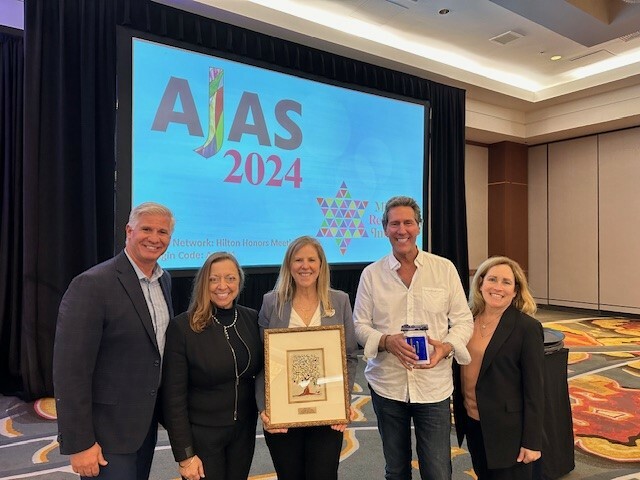
Turning Dreams Into Reality at Los Angeles Jewish Health Leads to Prestigious AJAS Award
Seniors move to Los Angeles Jewish Health for a wide variety of reasons. Many have specific medical needs; some are isolated and seeking community; others require skilled nursing care. Whatever the reason, members of the compassionate Los Angeles Jewish Health team are dedicated to fostering an environment where older adults don’t simply survive – they thrive.
“Someone might arrive at Los Angeles Jewish Health thinking, ‘I have come here to die,’ but we believe just the opposite: They have come here to live!” says Chief Mission Officer Rabbi Karen Bender. “We challenge residents to think that it’s entirely possible that the most meaningful moment of their life has not yet happened, and, that it’s going to happen here at LAJH. They might also touch someone else’s life, get to know them, and build the closest friendships and relationships they’ve ever had. Los Angeles Jewish Health is a place to find fulfillment and make new memories.”
To that end, last year Rabbi Bender and Ilana Springer, CEO/administrator at Los Angeles Jewish Health’s Joyce Eisenberg Keefer (JEK) Medical Center, launched Achieve a Dream, a pilot program focused on helping residents look forward to a future-oriented goal, inspiring a sense of growth, and enabling them to reach for something beautiful.
“We asked ourselves, ‘What would we want for our residents if they were our own mothers and fathers?’” Ilana says. “The idea was to create experiences that would bring them joy.”
In partnership with an with interdisciplinary staff including Susan Leitch, Claudia Crespo, Katie Abelson, Stacy Orbach, and Julie Lockman-Gold, the two piloted the program in the Joyce Eisenberg Keefer Medical Center, Los Angeles Jewish Health’s 239-bed skilled nursing facility, where the average resident age is 91.
“We felt the greatest need was with residents who require the highest level of care because they may be the least able to make dreams come true for themselves,” Ilana says.
First on the list was Elaine. One morning, Rabbi Bender visited her room and asked whether there was anything she dreamed about doing. Elaine immediately pointed to the photographs of horses hanging on her bedroom wall.
“She said, ‘Every single day of my life I was with horses, until 10 years ago. I haven’t even seen a horse since. I know I can’t ride, but I just want to spend quiet time with a horse.’” Rabbi Bender recalls. “So, we arranged to have a horse brought to one of the beautiful courtyards at Los Angeles Jewish Health, and Elaine enjoyed 90 minutes of one-on-one time. For an hour and a half, this was her horse; she had space to have a beautiful moment with an animal that meant the world to her.”
Since then, many more dreams have come to fruition:
Efraim, a rabbi living in the JEK Medical Center, had a dream of leading one last service. He was able to do so while also providing amazing musical accompaniment. Toward the end of the service, he poignantly said to his congregation of peers, “Look, I’m just like you. I can no longer walk or sing or do many important things I was once able to do, but we make do! And I couldn’t have done it without the encouragement of my best friends Joe and Richard” – friends he made at Los Angeles Jewish Health.
Andy had been in a rock band back when he attended an Ivy League college. He wanted nothing more than to jam on a bass guitar like he once did, though as a stroke survivor he couldn’t fully play anymore. Working with the care team, Rabbi Bender and Ilana found a college student who was a music major. The young man brought several electric instruments and electronic equipment and enabled Andy to experience “playing” the bass while his wife looked on adoringly. She later said it was one of the most meaningful experiences of their marriage.
Harriet, who had a love for chocolate, requested a chocolate tasting for the campus community. The Office of Volunteers went above and beyond arranging for a personal visit by three renowned chocolatiers, including a former White House chef, followed by a demonstration and tasting where the rest of the skilled nursing community was invited to enjoy the sweet treats.
In recognition of the program’s success, the Association of Jewish Aging Services (AJAS) announced Achieve a Dream as this year’s recipient of its prestigious Programming Award. Rabbi Bender and Ilana accepted the honor in person at AJAS’ national conference, which took place in late February in San Diego. Los Angeles Jewish Health Chief Executive Officer and President, Dale Surowitz, Board Member, Judy Friedman-Rudzki and Board Chair, Andrew Berman joined in the celebration.
“We are proud of this award but even more proud that Los Angeles Jewish Health is empowering seniors to come here and live with as much – if not more – fullness and purpose as they had before,” Rabbi Bender says. “This is a place where dreams really can come true.”
The Association of Jewish Aging Services (AJAS) awards Los Angeles Jewish Health's Achieve a Dream initiative as this year’s recipient of its prestigious Programming Award.
Mar
5
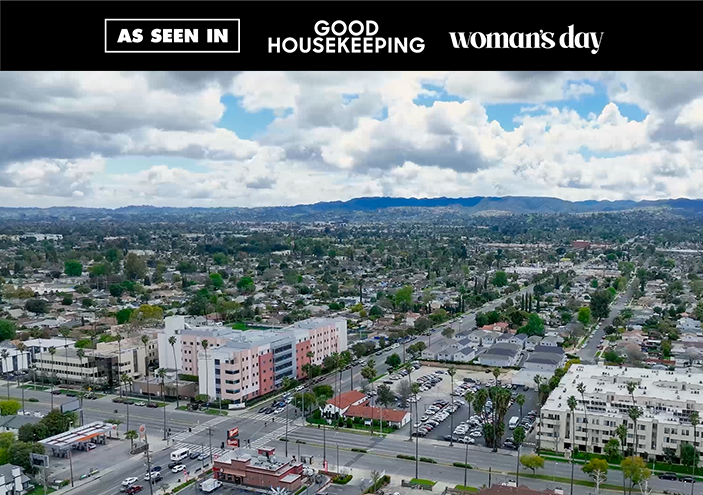
Vibrant Lifestyles Meet Quality Care at Los Angeles Jewish Health
For more than a century, Los Angeles Jewish Health (formerly Los Angeles Jewish Home) has cared for older adults with compassion, respect, and high-quality programs, services, and senior living options.
At Los Angeles Jewish Health, the art and science of caring for older adults has been cultivated over 100 years of service, earning the organization a second-to-none reputation in the region.
“One of the many things that stands out about our organization is our collaborative approach,” says Noah Marco, M.D., chief medical officer. “Throughout our history, we have emphasized the importance of bringing various professionals and specialists together to collaborate, communicate, and cooperate on behalf of each patient. We also maintain excellent relationships with the area’s leading hospitals and medical centers.”
Founded in 1912, Los Angeles Jewish Health has grown from a group of caring neighbors to a leading nonprofit organization, open to all, built on the Jewish values of charity, quality, dignity, and fiscal responsibility.
Compassion is at the core of every interaction, and a family approach permeates the culture.
“We treat residents like family, and we also consider our staff one big family. Together, we work for the safety, health, and well-being of the individuals in our care,” says Dr. Marco. “Every member of our team—from medical providers, pharmacists, and social workers to drivers, housekeepers, and maintenance staff—is enthusiastically dedicated to living our organization’s mission of serving and honoring older adults.”
With multiple locations and several levels of care within the Los Angeles Jewish Health network, head-to-toe services are provided—from primary care to physical therapy, dental, ophthalmology, optometry, dermatology, podiatry, and more.
Working as coordinated care teams ensures the best care is provided to the whole patient—mind, body, and spirit. This patient-centered model also mitigates the challenges of visiting several providers at multiple locations over weeks—a mental and logistical burden that often falls to a patient’s children or grandchildren.
The Grancell Village Campus of Los Angeles Jewish Health includes assisted living, PACE program, short term rehab, skilled nursing, senior behavioral health, a school of nursing and more
Levels of Care
To support seniors in maintaining healthy outcomes throughout their aging journey, Los Angeles Jewish Health offers a broad array of programs and services, including independent living, assisted living, senior behavioral health, short-term rehabilitation, skilled nursing, memory services, and hospice and palliative care.
The Brandman Centers for Senior Care offers comprehensive adult day services through their PACE program (Programs of All-Inclusive Care for the Elderly). This award-winning program allows more frail seniors to remain independent in their homes while receiving vital care and social services at their neighborhood location and offers transportation, home care, engaging activities, and medical care.
“PACE is designed to care for historically underserved populations who have complex medical and psychosocial conditions,” says Dr. Marco. “Our participant feedback shows high scores of satisfaction, particularly in the clinical services and the delicious meals we provide. Recognized as a top performer in this space, we are continually focused on expanding these services to more seniors in need.”
Caring Choices in Independent and Assisted Living
For active older adults interested in a continuing care retirement community, Los Angeles Jewish Health offers independent living accommodations.
For residents in the San Fernando Valley, Fountainview at Eisenberg Village in Reseda, California, features resort-style living with gourmet dining, an on-site movie theater, a bar/lounge, a state-of-the-art fitness facility, and a creative arts studio. A full-service staff provides expert care and attention to 108 independent living options, with optional nursing and care available.
Patient-Centered Telemedicine
With support from a grant from the Federal Communications Commission and generous donors, Los Angeles Jewish Health has invested heavily in state-of-the-art technology, including telemedicine, to expand its mission of patient-centered care.
Dr. Marco explains that standard healthcare has predominately been a physician-centered model, wherein patients must travel to the physician at the physician’s convenience. But in a patient-centered telemedicine approach, patients are seen in the comfort of their own home.
“When done correctly, telemedicine has incredibly high satisfaction rates. Providers can instantly look at and listen to a patient, and if a nurse is present with the patient, even use a stethoscope to listen to the heart and lungs. The data clearly shows that physicians are able to make diagnoses quickly and more accurately,” Dr. Marco says.
Effective telemedicine also reduces instances of unnecessary ambulance calls, which are costly and disruptive for patients, families, and caretakers alike.
Personalized Approach
With the benefit of expert gerontologists at the helm, Los Angeles Jewish Health focuses on the five M’s of geriatric care: mind, mobility, medications, multiple complexities, and what matters most to you.
“These five M’s are the difference between our tailored geriatric practice and a standard, fractionated approach to care,” says Dr. Marco. “We hyperfocus on learning each patient’s goals and needs so that their care can be as personal and effective as possible.
This article first appeared in Good Housekeeping and Woman's Day magazines in their January/February 2024 issue.
Dr. Noah S. Marco - Chief Medical Officer at Los Angeles Jewish Health
Feb
6
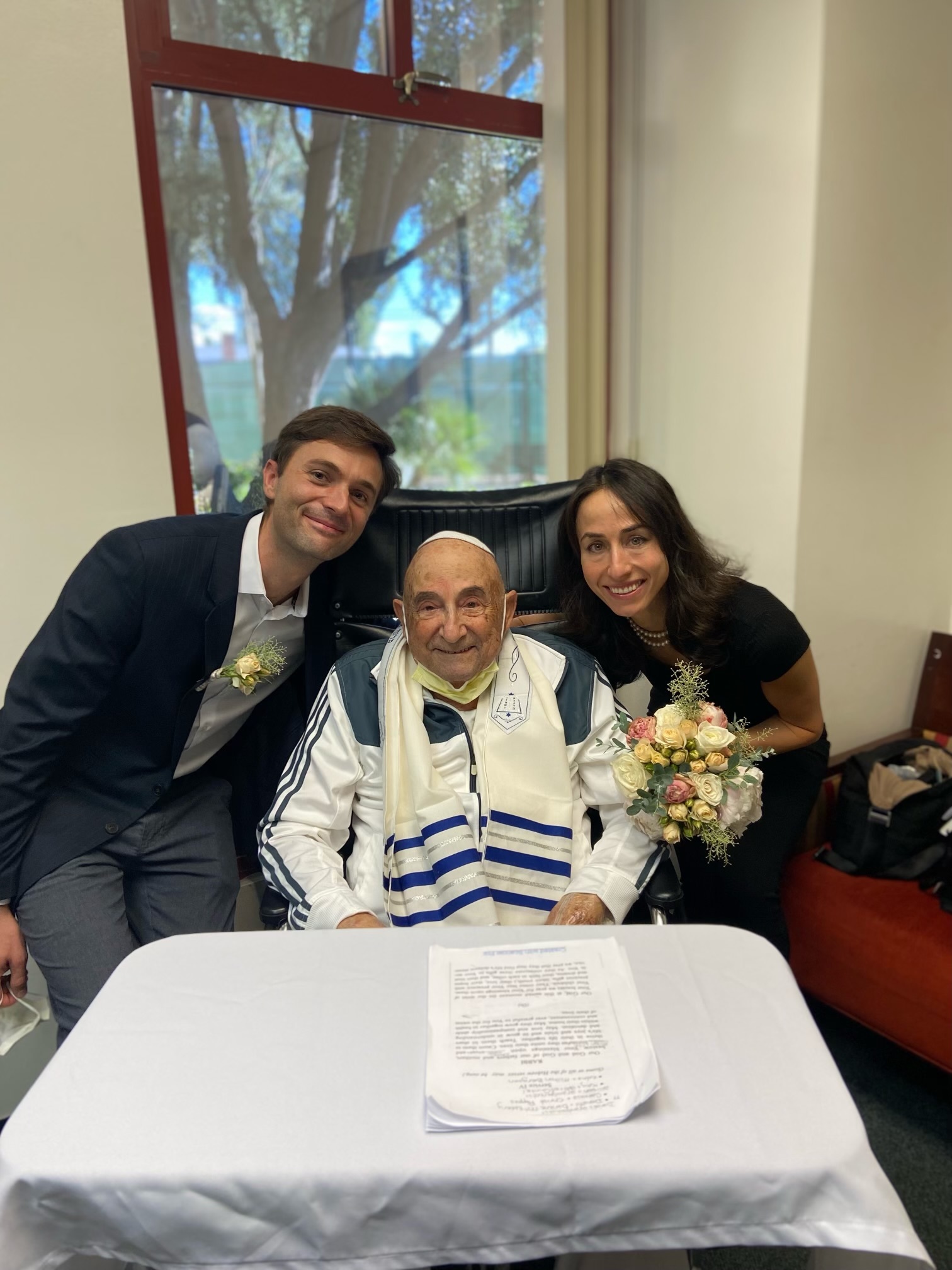
At Los Angeles Jewish Health Love Knows No Bounds
When 94-year-old Jack Schlaifer agreed to officiate at the wedding of his grandniece, Alison, and her fiancé, Daniel, he was building on a family tradition: months earlier, he had performed the marriage ceremony for Alison’s father (his nephew Charles) in the backyard of his Westlake Village home. Jack was honored when Alison asked him to do the honors for her wedding as well. They laid out plans for a similar ceremony, in the same venue, on New Year’s Day—until life got in the way.
“In November, I had a fall, and I fractured my L5 [a region between the lumbar and sacral spine in the lower back],” Jack says. “Suddenly, I was living in a rehabilitation facility, and all bets were off. I called Alison and told her, ‘You can’t count on me for the wedding.’ I was sad about it, but what could I do?”
Alison knew exactly what he should do: proceed full steam ahead. "She said, “Uncle Jack, I don’t care where you are; I want you to marry us. We’ll come to wherever you are!’” he recalls. “I was incredibly moved.”
All that was left was to coordinate with the staff at Los Angeles Jewish Health. LAJH is a place that Jack, a native Angeleno who had raised his family in the Valley, had long known and loved. “I joined The Guardians (a support group of LAJH) in 1980, and when they formed The Executives, I was a founding member and, later, president,” he said. “I served on The Executives’ board for 30 years.”
Jack reached out to Los Angeles Jewish Health staff, and everyone enthusiastically leaned in to ensure all details were arranged. On January 1, 2024, in a cozy family room on the Grancell Village campus, Jack gathered together with Alison, Daniel, and an intimate group of family to give the couple his blessing and pronounce them “man and wife.”
“It was an amazing wedding, and it brought me a lot of naches [joy],” Jack says, smiling. “After it was over, the family went for sandwiches to Brent’s Deli, which is Alison and Daniel’s favorite place. It was perfect.”
Once the ceremony was complete, it was back to the hard work of rehab. Every day Jack has both physical and occupational therapy, and every day he gets a little bit stronger. While the road to recovery is long, he is grateful to be walking it at Los Angeles Jewish Health.
“I’m lucky to be here,” he says. “The care is wonderful, and the people are great.”
Feb
6
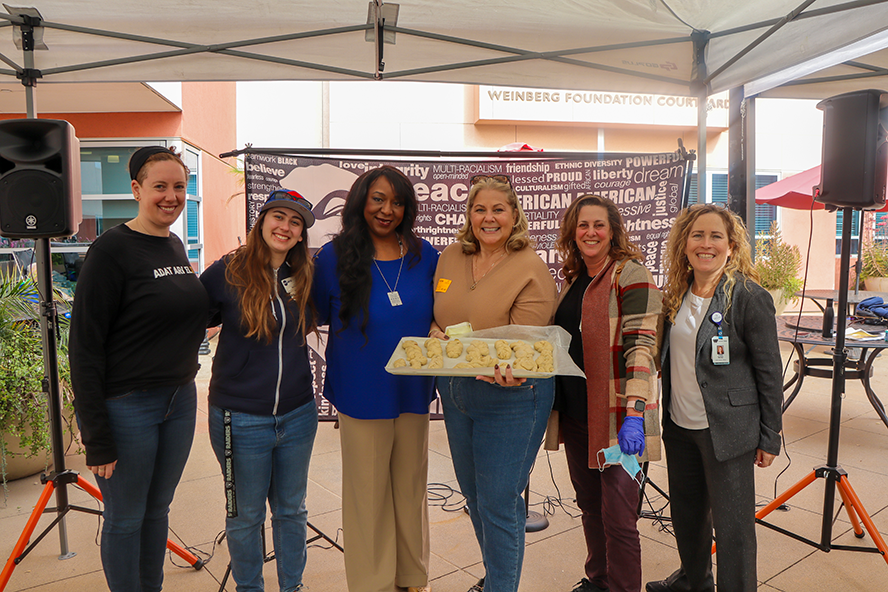
Special Intergenerational Program Honors Martin Luther King, Jr. and the Spirit of Coming Together for the Greater Good
Members of the Jewish and African-American communities have long found solidarity in common purpose, with a history of teaming up toward the pursuit of equal rights. As the New Year began, two diverse community groups gathered at Los Angeles Jewish Health to remember the legacy of the late Rev. Dr. Martin Luther King, Jr. while continuing to build toward a unified future. They literally came together to break bread.
In collaboration with Challah and Soul, a program that seeks to educate and unite the Jewish and Black communities, high school students from Adat Ari El congregation traveled to Los Angeles Jewish Health for an adventure in baking and storytelling. During the fascinating intergenerational event, LA Jewish Health residents shared memories of Dr. King as they worked side-by-side with the students to braid loaves of challah. The result: a wonderful afternoon of raising awareness, passing along a beloved Jewish tradition, and fostering strong intergenerational bonds.
“The students arrived with smiles and great energy,” says Susan Leitch, community manager and safety officer at Los Angeles Jewish Health and a key organizer of the event. “It was wonderful to see them interact with our seniors.”
Created by Shonda Isom Walkowitz, the founder of Bucks Happy Farm in the Lucerne Valley, and Judi Leib, a chef and veteran of the food services industry, Challah and Soul was built on a mutual interest in helping Blacks and Jews rediscover the things that make them natural allies. As challah dough was passed to the assembled residents and students, Judi spoke about the importance of food in uniting diverse people, and Shonda offered her thoughts about the similarities between the Black and Jewish experiences.
“This event showcased how much wisdom and perspective LA Jewish Health seniors can offer to the broader community,” Julie Lockman-Gold, special projects coordinator at Los Angeles Jewish Health, says. “Especially during a time of rising anti-Semitism, our residents have a lot to say about inequality, injustice, and racism. Giving them an opportunity to be heard – and for students to learn from their experiences – was truly meaningful.”
The event drew a large turnout of residents from Grancell Village’s Mark Taper Building and Joyce Eisenberg-Keefer Medical Center, as well as 20 Adat Eri El students and some of their family members.
“Watching them partner to make the challah, you could see the joy on everyone’s faces,” Julie recalls. “When the bread was done baking, the smell was amazing, and people were so excited to dig in!”
By the end of the afternoon, the happiness and contentment that filled the room were clear indications of the event’s success. It was a feeling shared by all participants. Julie added, “As the students were leaving, Adat Ari El’s program director, Sara Markus, told me she’s already thinking about doing it again next year!”